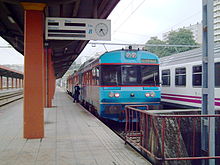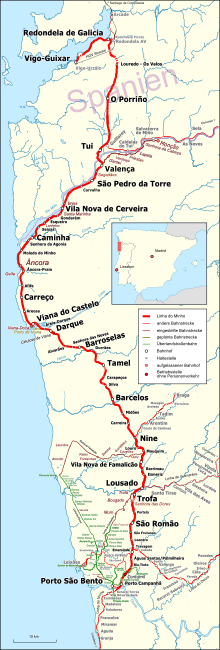Celta (train)
Celta is a joint train connection of the Portuguese railway company Comboios de Portugal and the Spanish railway company Renfe Operadora . The name refers to the direct trains between Porto ( Portugal ) and Vigo ( Spain ). The name was introduced in July 2013, and trains between Portugal and Galicia have existed since 1868.
history
First connections
The first train connection from Portugal to Spain began its service on January 10, 1868, connecting Lisbon with Vigo three times a week, and a little later also daily. The direct train connection between Porto and Vigo began in 1913. In 1980 there were two pairs of trains per day on the Porto São Bento – Vigo route, with stops en route in Viana do Castelo , Valença (border station), Tui , Guillarei and Redondela . The trains needed 4:24 for this route, including passport controls. From 1984 there were three pairs of trains a day.
Train traffic from 2000
In 2001 there were two pairs of trains a day with an average travel time of 3:15. The trains stopped in Viana do Castelo, Valença, Tui, Guillarei, O Porriño and Redondela.
In 2005 the Portuguese CP decided to discontinue the connection because it was not competitive in comparison to motorized private transport. According to the railway company, it lost 7.7 million passengers between 2001 and 2004. It was only after protests from the Galician community representatives and customer associations that the Portuguese railway company did not implement its plans.
In 2011 the CP once again announced its intention to officially cease traffic to Vigo due to construction work. In addition, the number of customers has fallen rapidly, between Valença and Vigo 15,500 passengers use the trains per year, which corresponds to 11 passengers per trip. The Spanish railway company Renfe supported the plans of the CP. Again a storm of protest from customer associations and the Portuguese Communist Party formed . The CP then withdrew its plans after it had agreed with Renfe that the trips on the Spanish side would be paid for by Renfe. Until then, the Portuguese railway company was solely responsible for the costs, which amounted to a good 232,000 euros per year.
Since August 2011, the trains no longer end at Vigo-Urzáiz station , but are diverted to the newly built Vigo-Guixar station . Urzáiz station has since been rebuilt in order to be connected to the Spanish high-speed network.
Introduction of the Celta
At the 25th Iberian Summit in Porto in 2012 , a regular meeting between the Portuguese and Spanish governments, Portugal committed itself to modernizing the railway line to Vigo ( Linha do Minho ) by 2016. In addition, both sides agreed to set up a new, direct train offer with a special ticket offer between Porto and Vigo.
On July 2, 2013, the CP then introduced the new train service under the name Celta . Since then, two pairs of trains have been running between Porto and Vigo each day without stopping, which has reduced the journey time to 2:15. Thereupon, however, protests in particular the Portuguese neighboring communities, above all Viana do Castelo and Nine , as well as the lobby association “Eixo Atlántico” that they no longer have a direct train connection to Galicia. As an alternative, however, there have since been trains to the Portuguese-Spanish border, where it is again possible to change to Renfe regional trains . It was also criticized that the establishment of the Celta offer was a purely political decision and not a decision based on market-economy criteria.
Between July and October 2013, 19,900 passengers took the train connection, and between July and March 2014 28,000 passengers, which corresponds to an average of 26 passengers per journey. According to media reports, the operation is thus highly deficient, the costs then amounted to a good 1.2 million euros until May 2014. The two state railway companies responded to the criticism and introduced a new timetable on July 1, 2014, since then the trains have also stopped in Nine, Viana do Castelo and Valença.
With the new timetable, staff changes between CP and Renfe have also been abolished. Until now, this was necessary because there is no modern train control system between the stations in Nine and Valença and the train driver has to have the interlocking approve the journeys by radio in the 90-kilometer section. The Spanish rail workers' union did not consider it appropriate for the 64 drivers based in Galicia to have to learn Portuguese. As of July 1, 2014, nine Portuguese and four Spanish train drivers each learned the language of the neighboring country, making staff changes obsolete.
On September 9, 2016, there was a serious accident when the train derailed at O Porrino. 4 people were killed, including the Portuguese train driver. 48 people were rushed to hospital with injuries.
Vehicle use

Since most of the traveled route, the Linha do Minho , is not electrified, vehicle use is limited to diesel-powered vehicles. Diesel multiple units have been in continuous use since the 1980s at the latest.
In recent years, the Comboios de Portugal have usually used class 0450 diesel multiple units . In 2011, the Portuguese railway company lent 17 vehicles of the RENFE series 592 , which since then have been serving on the route to Vigo in addition to the Linha do Douro . These are three-part diesel multiple units, exclusively second class, with train toilets, but without gastronomic service. Since then, it has been prohibited to take bicycles with you as there is no space for them.
It is planned to use newer vehicle material from Renfe, according to media reports either trains from the 594 or 598 series .
Web links
- Timetable of the Celta on the website of the CP (Portuguese, English; PDF)
Individual evidence
- ↑ Caminhos de Ferro Portugueses: Horário Verão 1980. (PDF) April 30, 1979, accessed on March 3, 2014 (Portuguese, digitized by the Departamento de Informática of the Universidade do Minho, Braga, April 2006).
- ↑ Caminhos de Ferro Portugueses: Horário Verão 1984. (PDF) May 15, 1983, accessed on March 3, 2014 (Portuguese, digitized by the Departamento de Informática of the Universidade do Minho, Braga, April 2006).
- ↑ Marcha atrás no fim do comboio Porto-Vigo. Jornal de Notícias, June 6, 2005, accessed March 3, 2014 (Portuguese).
- ↑ Linha Porto-Vigo tem 11 passageiros por viagem. Diário de Notícias, July 5, 2011, accessed March 3, 2014 (Portuguese).
- ↑ Carlos Cipriano: Espanhóis aceitam fim da ligação de comboios Porto-Vigo. In: Público . July 4, 2011, accessed March 3, 2014 (Portuguese).
- ↑ Utentes e PCP criticam fim das ligações ferroviárias entre Porto e Vigo. (No longer available online.) Jornalismo Porto Net (JPN) July 4, 2011, archived from the original on November 13, 2013 ; Retrieved March 3, 2014 (Portuguese). Info: The archive link was inserted automatically and has not yet been checked. Please check the original and archive link according to the instructions and then remove this notice.
- ^ Carlos Cipriano: Comboios Porto-Vigo vão manter-se. In: Público. July 8, 2011, accessed March 3, 2014 (Portuguese).
- ↑ Ruth Villar: Inaugurada la estación de tren de Guixar y las obras de la de Urzáiz comienzan el 24 de septiembre. Vigo al Minuto, August 27, 2011, accessed March 3, 2014 (Spanish).
- ↑ Lusa: Cimeira Ibérica: Comboio directo diário e bilhete único entre Porto e Vigo a partir do verão. SOL.pt, May 13, 2013, accessed March 3, 2014 (Portuguese).
- ↑ Comboio "Celta" começa hoje a ligar Porto e Vigo sem paragens. Expresso, July 2, 2013, accessed March 3, 2014 (Portuguese).
- ^ Carlos Cipriano: Autocarro é mais rápido e mais barato do que o novo comboio Porto-Vigo. Retrieved March 3, 2014 .
- ↑ Efe: El Eixo Atlántico confirma la viabilidad del tren ´Celta´. In: Faro de Vigo. November 15, 2013, Retrieved July 16, 2014 (Spanish).
- ↑ Para gene em Viana e Nine reforçariam sucesso do comboio "Celta" - Eixo Atlântico. Porto Canal, November 12, 2013, accessed March 3, 2014 (Portuguese).
- ^ Andreia Cruz: Novo comboio Porto-Vigo parte segunda-feira. In: Público. June 29, 2013, Retrieved March 3, 2014 (Portuguese).
- ^ A b Comboio "Celta" com paragem em Viana do Castelo a partir de junho. Diário Digital, May 1, 2015, accessed May 5, 2014 (Portuguese).
- ↑ Carlos Cipriano: Comboio entre Porto e Vigo acumulou prejuízos de 1,2 milhões de euros em nove meses. In: Público. May 19, 2014, accessed July 1, 2014 (Portuguese).
- ^ Carlos Cipriano: CP prolonga o aluguer de automotoras espanholas que estão no Douro e Minho. In: Público. March 19, 2014, accessed March 24, 2014 (Portuguese).
- ↑ Álvaro Vieira: Maquinistas espanhóis nicht querem trazer o comboio Celta até ao Porto. In: Público. September 27, 2013, accessed March 3, 2014 .
- ↑ Carlos Cipriano: Novas paragens no comboio Celta não penalizam tempo de percurso. In: Público. June 29, 2014. Retrieved July 16, 2014 (Portuguese).
- ^ Rheinische Post: Train accident in O Porriño: train derailed in Spain, several dead , September 9, 2016, accessed on September 10, 2016
- ^ Carlos Cipriano: Comboio Porto-Vigo vai ser mais confortável e ter paragens em cidades do Minho. In: Público. May 24, 2014, accessed July 1, 2014 (Portuguese).




